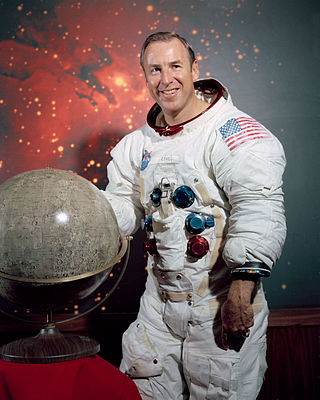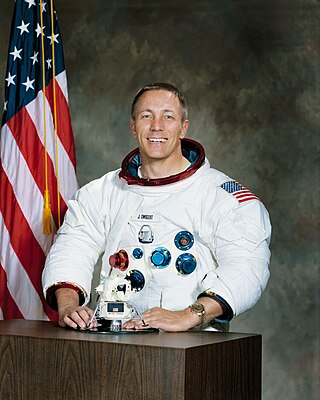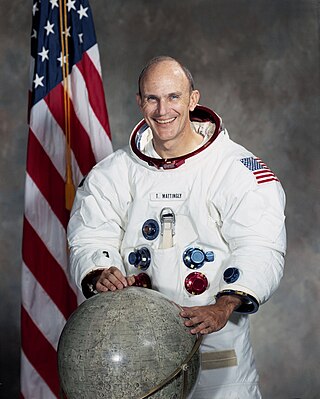
Apollo 11 was the American spaceflight that first landed humans on the Moon. Commander Neil Armstrong and Lunar Module Pilot Buzz Aldrin landed the Apollo Lunar Module Eagle on July 20, 1969, at 20:17 UTC, and Armstrong became the first person to step onto the Moon's surface six hours and 39 minutes later, on July 21 at 02:56 UTC. Aldrin joined him 19 minutes later, and they spent about two and a quarter hours together exploring the site they had named Tranquility Base upon landing. Armstrong and Aldrin collected 47.5 pounds (21.5 kg) of lunar material to bring back to Earth as pilot Michael Collins flew the Command Module Columbia in lunar orbit, and were on the Moon's surface for 21 hours, 36 minutes before lifting off to rejoin Columbia.

Apollo 8 was the first crewed spacecraft to leave low Earth orbit and the first human spaceflight to reach the Moon. The crew orbited the Moon ten times without landing, and then departed safely back to Earth. These three astronauts—Frank Borman, James Lovell, and William Anders—were the first humans to witness and photograph the far side of the Moon and an Earthrise.

The Apollo program, also known as Project Apollo, was the United States human spaceflight program carried out by the National Aeronautics and Space Administration (NASA), which succeeded in preparing and landing the first men on the Moon from 1968 to 1972. It was first conceived in 1960 during President Dwight D. Eisenhower's administration as a three-person spacecraft to follow the one-person Project Mercury, which put the first Americans in space. Apollo was later dedicated to President John F. Kennedy's national goal for the 1960s of "landing a man on the Moon and returning him safely to the Earth" in an address to Congress on May 25, 1961. It was the third US human spaceflight program to fly, preceded by the two-person Project Gemini conceived in 1961 to extend spaceflight capability in support of Apollo.

Apollo 13 was the seventh crewed mission in the Apollo space program and the third meant to land on the Moon. The craft was launched from Kennedy Space Center on April 11, 1970, but the lunar landing was aborted after an oxygen tank in the service module (SM) ruptured two days into the mission, disabling its electrical and life-support system. The crew, supported by backup systems on the lunar module (LM), instead looped around the Moon in a circumlunar trajectory and returned safely to Earth on April 17. The mission was commanded by Jim Lovell, with Jack Swigert as command module (CM) pilot and Fred Haise as lunar module (LM) pilot. Swigert was a late replacement for Ken Mattingly, who was grounded after exposure to rubella.

Apollo 12 was the sixth crewed flight in the United States Apollo program and the second to land on the Moon. It was launched on November 14, 1969, by NASA from the Kennedy Space Center, Florida. Commander Charles "Pete" Conrad and Lunar Module Pilot Alan L. Bean performed just over one day and seven hours of lunar surface activity while Command Module Pilot Richard F. Gordon remained in lunar orbit.

Apollo 14 was the eighth crewed mission in the United States Apollo program, the third to land on the Moon, and the first to land in the lunar highlands. It was the last of the "H missions", landings at specific sites of scientific interest on the Moon for two-day stays with two lunar extravehicular activities.

Apollo 13 is a 1995 American docudrama film directed by Ron Howard and starring Tom Hanks, Kevin Bacon, Bill Paxton, Ed Harris, and Gary Sinise. The screenplay by William Broyles Jr. and Al Reinert dramatizes the aborted 1970 Apollo 13 lunar mission and is an adaptation of the 1994 book Lost Moon: The Perilous Voyage of Apollo 13, by astronaut Jim Lovell and Jeffrey Kluger.

Charles Moss Duke Jr. is an American former astronaut, United States Air Force (USAF) officer and test pilot. As Lunar Module pilot of Apollo 16 in 1972, he became the 10th and youngest person to walk on the Moon, at age 36 years and 201 days.

James Arthur Lovell Jr. is an American retired astronaut, naval aviator, test pilot and mechanical engineer. In 1968, as command module pilot of Apollo 8, he became, with Frank Borman and William Anders, one of the first three astronauts to fly to and orbit the Moon. He then commanded the Apollo 13 lunar mission in 1970 which, after a critical failure en route, looped around the Moon and returned safely to Earth.

John Leonard Swigert Jr. was an American NASA astronaut, test pilot, mechanical engineer, aerospace engineer, United States Air Force pilot, and politician. In April 1970, as command module pilot of Apollo 13, he became one of 24 astronauts who flew to the Moon. Ironically, due to the "slingshot" route around the Moon they chose to safely return to Earth, the Apollo 13 astronauts flew farther away from Earth than any other astronauts before or since, though they had to abort the Moon landing.

Fred Wallace Haise Jr. is an American former NASA astronaut, engineer, fighter pilot with the U.S. Marine Corps and U.S. Air Force, and a test pilot. He is one of 24 people to have flown to the Moon, having flown as Lunar Module pilot on Apollo 13. He was slated to become the 6th person to walk on the Moon, but the Apollo 13 landing mission was aborted en route.

Thomas Kenneth Mattingly II was an American aviator, aeronautical engineer, test pilot, rear admiral in the United States Navy, and astronaut who flew on Apollo 16 and Space Shuttle STS-4 and STS-51-C missions.

Ullage motors are relatively small, independently fueled rocket engines that may be fired prior to main engine ignition, when the vehicle is in a zero-g situation. The resulting acceleration causes liquid in the rocket's main tanks to settle towards the aft end, ensuring uninterrupted flow to the fuel and oxidizer pumps.

Lunar plaques are stainless steel commemorative plaques measuring 9 by 7+5⁄8 inches attached to the ladders on the descent stages of the United States Apollo Lunar Modules flown on lunar landing missions Apollo 11 through Apollo 17, to be left permanently on the lunar surface. The plaques were originally suggested and designed by NASA's head of technical services Jack Kinzler, who oversaw their production.

John W. Aaron is a former NASA engineer and was a flight controller during the Apollo program. He is widely credited with saving the Apollo 12 mission when it was struck by lightning soon after launch, and also played an important role during the Apollo 13 crisis.

NASA Astronaut Group 5 was a group of nineteen astronauts selected by NASA in April 1966. Of the six Lunar Module Pilots that walked on the Moon, three came from Group 5. The group as a whole is roughly split between the half who flew to the Moon, and the half who flew Skylab and Space Shuttle, providing the core of Shuttle commanders early in that program. This group is also distinctive in being the only time when NASA hired a person into the astronaut corps who had already earned astronaut wings, X-15 pilot Joe Engle. John Young labeled the group the Original Nineteen in parody of the original Mercury Seven astronauts.

Apollo 11 was the first human spaceflight to land on the Moon. The 1969 mission's wide effect on popular culture has resulted in numerous portrayals of Apollo 11 and its crew, Neil Armstrong, Buzz Aldrin, and Michael Collins.
"Houston, we have a problem" is popularly quoted as a phrase spoken during Apollo 13, a NASA mission in the Apollo space program and the third meant to land on the Moon. After an explosion occurred on board the spacecraft en route to the Moon at 55:54:53, Jack Swigert, the command module pilot, reported to Mission Control Center in Houston, Texas: "Okay, Houston ... we've had a problem here." After being prompted to repeat his words by Jack R. Lousma, the capsule communicator at Mission Control, Jim Lovell, the mission commander, responded: "Ah, Houston, we've had a problem."

The Astronaut Monument is a monument commemorating the training of Apollo astronauts in northern Iceland in 1965 and 1967. It is located outside the Exploration Museum in Húsavík, and contains the names of 32 Apollo astronauts who were sent to Iceland for training in geology for crewed lunar missions. Fourteen of the trainee astronauts later flew to the Moon, and seven of those conducted geology work on the lunar surface.


















